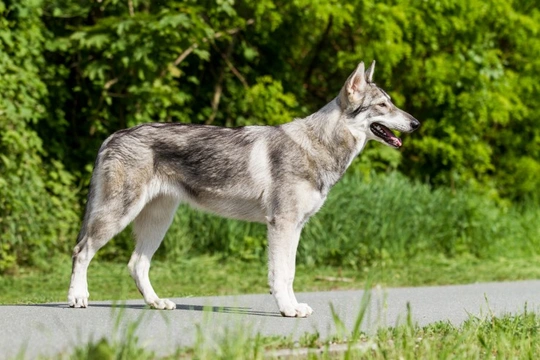
A distinctive and appealing hybrid dog type: The Northern Inuit dog
The Northern Inuit dog is a large, outgoing and very wolf-like dog type that always turns heads thanks to their imposing appearance and unmissable good looks!
The Northern Inuit is not hugely common in the UK, being ranked 141st in the popularity stakes out of a total of 241 different dog breeds and types, which only serves to make them more eye-catching and distinctive when you do spot one – and many people fall for their charms immediately, which means there is actually quite a lot of interest in this dog type as a whole. Northern Inuit dogs are also the dog type used in the hugely popular Game of Thrones TV series to represent the direwolves – which also helped to raise their profile in recent years and increase interest in them among the general public.
However, the Northern Inuit is not only a large dog but one with a complex personality, which requires an experienced, insightful owner to manage them and provide for all of their needs.
If you want to learn more about the Northern Inuit dog or are perhaps wondering if you might have what it takes to own one, this article will outline some of the Northern Inuit’s core traits in terms of temperament and care considerations. Read on to learn more.
What is a Northern Inuit dog?
A Northern Inuit dog is a cross breed or hybrid dog type, with various different breeds having some input into their mix. The three breeds that are most widely associated with the Northern Inuit ancestry are the Siberian husky, German shepherd and Alaskan malamute, and many dogs of this type will have mixed ancestry contributed by all three breeds – but often, a crossing of any two dogs in the mix is referred to as a Northern Inuit dog too.
They are large spitz-type dogs with a wolf-like appearance, and they also tend to be protective, bold, outgoing and vitally, full of beans and with masses of energy.
Is the Northern Inuit a pedigree dog breed?
The Northern Inuit dog is not a pedigree breed, and so there is no formal breed standard in place and dogs of this type cannot be registered with The Kennel Club. This is because there is no accepted norm in terms of the Northern Inuit’s breed makeup, appearance and ancestry, but a high level of variation across all dogs that are referred to as being of this type.
Individual Northern Inuit dogs may be bred by crossing pedigrees of their respective parent breeds, but the Northern Inuit itself is not a pedigree.
How much do Northern Inuit dogs cost to buy and keep?
The average advertised price of Northern Inuit dogs in the UKon the Pets4Homes website is around £794, which is reasonably high for a non-pedigree dog type, but is within the average norms for the more popular and/or in demand hybrid dog types.
Large dog types tend to be more expensive to buy than their smaller counterparts in general, and the relative rarity of Northern Inuit dogs compared to demand for them – coupled with the often high costs involved in owning (and so, breeding from) large dogs is reflected in the average sale price for puppies.
In terms of the costs involved in owning and caring for a Northern Inuit dog, they tend to be on the high side – large dogs need large accessories, and everything from veterinary care to insurance tends to be higher too. They are also hugely active dogs that need a lot of food, and so the Northern Inuit can be rather expensive to keep.
The Northern Inuit temperament
The Northern Inuit temperament is quite distinctive, and they are just as memorable for their personalities as they are for their looks. They are confident, outgoing and engaging dogs with very inquisitive temperaments – they like to keep an eye on everything that is going on around them and get involved in it too if possible!
They also tend to be highly social, loving the company of other dogs and fitting in well within a pack or multi-dog home. The majority of Northern Inuit dogs are also generally personable and very direct about approaching and greeting new people, although the German shepherd side of the heritage of some dogs of this type may make them a little more speculative than others.
Northern Inuit dogs are among the most energetic and active of all dog types, and they also have bags of endurance. They can run and play for hours without tiring, which can make providing for their need for physical activity very challenging. A Northern Inuit dog that is bored, frustrated or not getting enough exercise may well take it into their own paws to resolve the issue, making them sometimes prone to climbing or jumping out of their gardens and taking themselves off for a run, particularly if something interesting is going on elsewhere!
They are intelligent dogs that learn quickly, and that often learn a lot from other dogs – and so they need an experienced and switched on trainer who can capture their attention and channel their core traits into positive directions. Training should be varied, interesting and ongoing, and managing the dog’s prey drive and recall skills is also something that needs to be tackled carefully.
Northern Inuit dogs can make for very rewarding companions, but they are large strong, and guaranteed to keep even a savvy owner on their toes – as well as needing a lot of walks and attention. This means that they are not a good choice of pet for everyone, but for an active, experienced owner who likes to walk, jog, hike or run, they may be the perfect fit.



